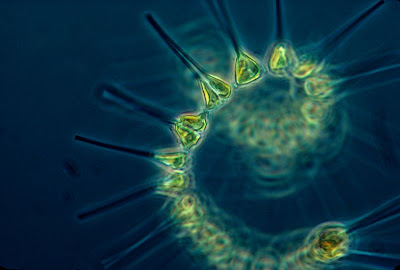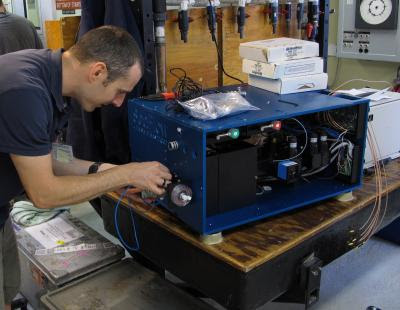(Phytoplankton. Photo courtesy the NOAA MESA Project.)
The ocean just got richer than we ever imagined—thanks to a new flow cytometer that measures the size and pigment composition of every phytoplankter present in a sample of seawater at the mind-blowingly fast rate of thousands of cells per second.
With that stream of data, researchers from the University of Washington found that communities of phytoplankton south of Vancouver Island, British Columbia, are big players when it comes to carbon: sequestering up to 50 percent of atmospheric carbon dioxide in the ocean.
(Phytoplankton bloom off Vancouver Island. NASA image courtesy Jeff Schmaltz, MODIS Land Rapid Response Team at NASA GSFC.)
(François Ribalet prepares the SeaFlow at the start of a recent expedition. Photo courtesy the University of Washington.)
The new technology collects more samples in a day than most scientists normally gather on an entire cruise. It also sorts the phytoplankton into distinct communities, completing work in five minutes that takes two months with traditional cytometers and microscopes.
(Diatoms. Photo by Prof. Gordon T. Taylor, Stony Brook University, courtesy Wikimedia Commons.)
Here, Ribalet et al found not one but five oceanic phytoplankton communities, each taking advantage of the concentrations of carbon and nutrients.
“This was just unexpected diversity,” Ribalet says. “It flies in the face of the textbooks.”
(Phytoplankton. Photo courtesy the NOAA MESA Project.)
The researchers also discovered the phytoplankton hotspot sequesters 50 percent of atmospheric carbon dioxide produced nearby.
Here’s the abstract of the paper in PNAS:
In terrestrial ecosystems, transitional areas between different plant communities (ecotones) are formed by steep environmental gradients and are commonly characterized by high species diversity and primary productivity, which in turn influences the foodweb structure of these regions. Whether comparable zones of elevated diversity and productivity characterize ecotones in the oceans remains poorly understood. Here we describe a previously hidden hotspot of phytoplankton diversity and productivity in a narrow but seasonally persistent transition zone at the intersection of iron-poor, nitrate-rich offshore waters and iron-rich, nitrate-poor coastal waters of the Northeast Pacific Ocean. Novel continuous measurements of phytoplankton cell abundance and composition identified a complex succession of blooms of five distinct size classes of phytoplankton populations within a 100-km–wide transition zone. The blooms appear to be fueled by natural iron enrichment of offshore communities as they are transported toward the coast. The observed succession of phytoplankton populations is likely driven by spatial gradients in iron availability or time since iron enrichment. Regardless of the underlying mechanism, the resulting communities have a strong impact on the regional biogeochemistry as evidenced by the low partial pressure of CO2 and the nearly complete depletion of nutrients. Enhanced phytoplankton productivity and diversity associated with steep environmental gradients are expected wherever water masses with complementary nutrient compositions mix to create a region more favorable for phytoplankton growth. The ability to detect and track these important but poorly characterized marine ecotones is critical for understanding their impact on productivity and ecosystem structure in the oceans.
Francois Ribalet, et al. Unveiling a phytoplankton hotspot at a narrow boundary between coastal and offshore waters. PNAS.




















